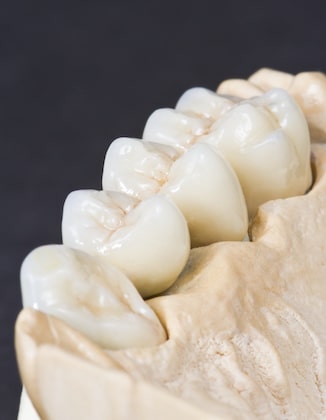
Patients who are missing any of their teeth can visit a dentist who will close the gaps in the teeth with a dental bridge. In general, a dental bridge is a pontic (false tooth) that is kept in place in the mouth by the abutment teeth on either side of the gap in the teeth. While a pontic can be created from a variety of materials, they are usually made from porcelain, so they have an aesthetic appearance that blends in with the natural teeth.
Ready to learn more about the benefits of a dental bridge? Get started with this in-depth video from Cosmetic Town TV:
 Patients who are considering having a dental bridge placed in the mouth need to know there are four main types of dental bridges:
Patients who are considering having a dental bridge placed in the mouth need to know there are four main types of dental bridges:
The ideal patient for a dental bridge procedure is a person who is missing one tooth or several teeth in the mouth. In addition, a good candidate for a dental bridge is a person who wants to improve the aesthetics and/or functionality of their teeth.
The benefits of having a dental bridge placed in the mouth include a restoration of the smile, an easier time properly speaking and pronouncing words, an improved ability to chew, and preventing the remaining natural teeth in the mouth from moving out of their correct position.
When it comes to deciding if dental bridges or dental implants are a better choice, the patient should keep in mind that a number of insurance plans cover dental bridges and some even cover dental implants.
It is also important to know that dental implants are viewed as a permanent solution for treating issues with missing teeth. On the other hand, a dental bridge might need to be replaced anywhere from five to fifteen years after it is placed in the mouth. The length of time that a dental bridge lasts in the mouth can be impacted by a lack of proper oral care.
The cost of a dental bridge depends on a number of factors. The price can run anywhere from $500-$1200 per tooth or pontic and the cost depends on the material used to create the bridge, the type of bridge that is placed in the mouth, the number of pontics that need to be placed in the mouth, and the amount of work the cosmetic dentist will need to perform. Insurance might cover part of the cost since the replacement of missing teeth is considered to be a functional issue with the mouth.
Patients who have missing teeth in their mouth need to visit an experienced dentist who is properly trained in the placement of dental bridges in the mouth. The dentist will examine the teeth to make sure the patient can benefit from the placement of a dental bridge and also determine the best dental bridge choice based on the individual needs of the patient.
- MA